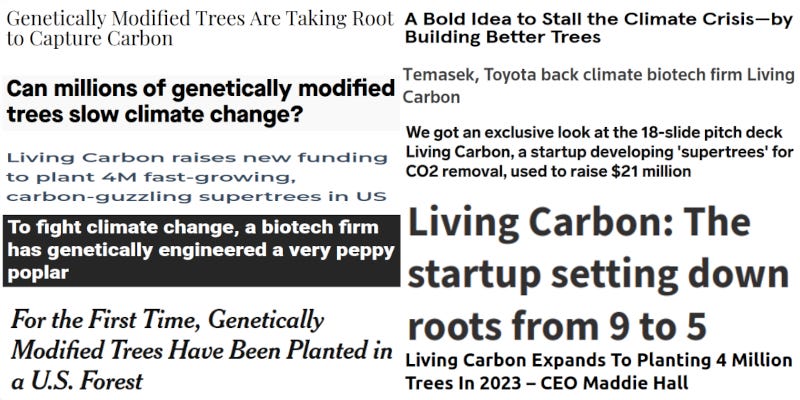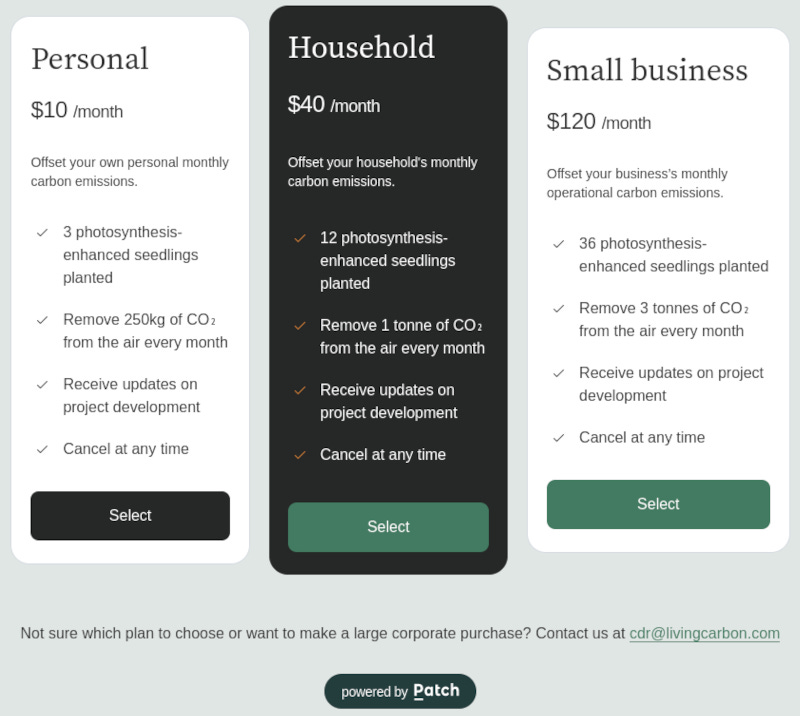Living Carbon is selling carbon offsets generated from planting genetically engineered trees: A false solution combined with a techno-fix on top of another false solution
Living Carbon is selling carbon offsets with no peer-reviewed science to back its claims.
On 16 February 2023, a company called Living Carbon planted almost 5,000 genetically-engineered poplar trees in southern Georgia, USA. The trees are genetically-engineered to grow quickly and to absorb more CO₂ from the atmosphere. The company has already started selling carbon credits that it hopes will be generated by the carbon that the trees absorb.
Living Carbon’s GE trees have received a fair bit of mostly positive publicity - as shown in the headlines above.
But this is a false solution to the climate crisis (tree planting), combined with a dangerous techno-fix (GE trees), added to another false solution (carbon trading). It’s a dangerous distraction from the urgent structural changes that are needed to address the climate crisis.
The company Living Carbon PBC was incorporated in the tax haven of Delaware in October 2019. The company has branches in Washington (February 2023), Massachusetts (August 2021), Arizona (June 2021), Georgia (March 2021), Minnesota (September 2022), and California (January 2020). Then there are two other “Living Carbon” companies: Living Carbon PBC, incorporated in South Carolina in March 2021, and Living Carbon PBC Inc., incorporated in North Carolina in January 2023.
The company’s co-founders are Maddie Hall and Patrick Mellor. Before the two met, Mellor was carrying out research into genetically engineered trees that would not rot — and therefore would not release their carbon back to the atmosphere. In a presentation at the Foresight Institute in August 2019, Mellow was looking to raise US$10 million over the next five years.
Maddie Hall previously worked for OpenAI, the Silicon Valley tech company that developed ChatGPT. Mellor and Hall met at a Foresight Institute climate tech conference.
Living Carbon has so far raised US$36 million from venture capital firms and Hall’s contacts in the tech-world. Funders include Singapore-based global investment company Temasek, Lowercarbon Capital, Toyota’s venture capital firm Toyota Ventures, Felicis Ventures, Y Combinator, the US Department of Energy, and OpenAI’s CEO Sam Altman.
Risky business
Genetically engineering trees is a risky business. They “pose risks of contaminating forests, damaging ecosystems, and harming communities”, as the Campaign to Stop GE Trees points out. Trees can live for many decades. If a genetically engineered trait escapes into the wild it will be impossible to put the genetically engineered genie back in the bottle. The damage is irreversible.
Living Carbon’s modified poplar trees are all female so they won’t produce pollen. They could however be pollinated by wild trees and produce seeds. The New York Times reports Mellor as saying that, “they’re unlikely to spread into the wild because they don’t breed with the most common poplar species in the Southeast”.
But according to a January 2023 article in Business Insider, Living Carbon is selling its GE seedlings in the USA in quantities of 1,000 and above. “They are being sold to anyone looking to run a carbon removal or nature restoration project, for timber production, or even for ornamental reasons.”
If true, this means that this is not a controlled trial of GE trees in one area of the country. Living Carbon’s GE trees could be planted anywhere in the USA.
An April 2022 article in Tech Crunch explains what Living Carbon’s genetic engineering involves:
“Living Carbon has spliced genes for enzymes from pumpkins and algae into the trees so the carbon dioxide is broken down inside the chloroplast and results in a more efficient process of converting CO₂ into sugar with less released back into the atmosphere.”
In fact, Living Carbon has very little scientific evidence that its genetically-engineered trees will actually do what they claim they will. The company claims that its GE poplar trees will grow 50% faster and will store 27% more carbon than non-GE poplar.
But there is no peer-reviewed science to back up these claims. All that Living Carbon can point to is a preprint paper that has not been peer-reviewed. It was first posted on the website bioRxiv on 19 February 2022 and the most recent version is dated 9 March 2023. The findings in that paper are based on observations of GE trees in a greenhouse over a five month period.
Steve Strauss is a geneticist at Oregon State University who has spent a large part of his career developing and promoting GE trees. When Living Carbon contacted him he was hesitant. “If it works, it would be a wonderful thing,” Strauss told E&E News. “But typically in research on agriculture or forestry, just because it works in the lab or the greenhouse, tells you nothing.”
Strauss was even more blunt speaking to the New York Times recently. “My experience over the years is that the greenhouse means almost nothing,” he said. “Venture capitalists may not know that.”
Strauss previously sat on Living Carbon’s scientific advisory board and has grown some of the company’s GE trees as part of a field trial funded by the company. The New York Times reports him saying that “the trees were growing well, but it was still too early to tell whether they were outpacing unmodified trees.”
Carbon offsets
Despite the complete lack of scientific evidence of what its GE trees can actually achieve, Living Carbon is already forward selling carbon offsets. In January 2023, Reuters reported Hall as saying that Living Carbon had “sold out of its carbon credits for 2023, but is doing pre-sales for the following two years.”
Living Carbon has a target of planting 4 million trees in 2023. “If we keep doubling the number of trees we plant every year,” Hall recently told Carbon Herald, “by 2030 we will have planted enough trees that over the lifetime of the project would remove 1.66% of 2021 global emissions.”
A September 2022 report by the Stop GE Trees Campaign and the Canadian Biotechnology Action Network includes a profile of Living Carbon that highlights that the company was selling carbon offsets long before it had planted a single tree in the ground.
In June 2022, a Japanese website, Persefoni, stated that,
“Living Carbon’s Hybrid Poplar Reforestation project was developed according to the Verra Verified Carbon Standard (VCS) ARR methodology”.
Living Carbon’s tree planting projects are not registered on Verra’s VCS Project Database. Describing the project as “developed according” to ARR (Afforestation, Reforestation and Revegetation) methodology is misleading — not least since at that time no trees had been planted!
The reference to Verra has now gone from Persefoni’s website.
In June 2022, Persefoni was selling Living Carbon’s offsets for US$40 each. This has now increased to US$75 each.
In July 2022, another Japanese website, e-dash, was selling Living Carbon’s offsets for about US$50 each. This website stated that,
“Living Carbon's Loblolly Pine Reforestation Project was developed according to the Verra Verified Carbon Standard (VCS) ARR methodology to increase the volume of carbon stored in durable wood products”.
Living Carbon has since been removed from e-dash’s website.
Meanwhile, Hugo Technologies Limited, a UK-based company that offers a smart meter app to save household energy use, also sells Living Carbon’s offsets. Back in July 2022, you could have bought one of Living Carbon’s Loblolly Pine Biotech-Enhanced Reforestation offsets for £45.34. Today, one of Living Carbon’s Hybrid Poplar Biotech-Enhanced Afforestation offsets will set you back £91.91. Hugo has 364 of these available with a 2026 vintage, and 999.98 with a 2027 vintage.
In June 2022, Living Carbon’s website featured an offer allowing individuals, households, or businesses to buy carbon offsets on a monthly basis - promising very specific amounts of CO₂ removals:
That’s now gone and Living Carbon asks anyone who wants to buy carbon offsets to contact them. The same sales pitch is still available on Patch’s website - Patch is the payment processing company that Living Carbon uses.
All of these carbon offsets are being sold before they are validated or verified in any way. Many of them were on sale before a single tree had been planted. And all of them were sold in the complete absence of any peer-reviewed science showing that Living Carbon’s GE trees will achieve what the company claims they will.








Besides the above mentioned problems, to say that a tree "would not rot" is a big red flag, indicating some amorphous emission from the back-side of a male bovine. It is either wood or plastic - pick one answer. Either way, it could burn in a forest fire. The life of a tree is nothing compared to the tens of thousands of years life of a CO2 emission.